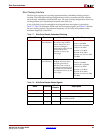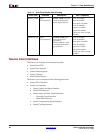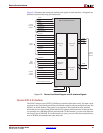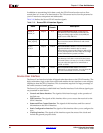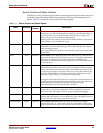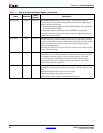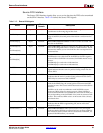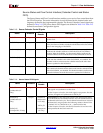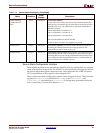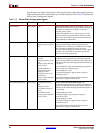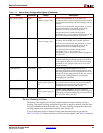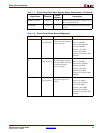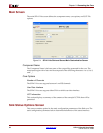
SPI-4.2 Lite v4.3 User Guide www.xilinx.com 37
UG181 June 27, 2008
Source Core Interfaces
R
Source Static Configuration Interface
These signals are inputs to the core that are statically driven by setting them to a constant
value in the top-level wrapper file. The SPI-4.2 Lite release includes a wrapper file that has
the static configuration signals connected to the values selected in the CORE Generator
GUI. Customization of these signals is done using the GUI.
Three of the Source Static Configuration signals can be changed in-circuit. There are static
registers for
SrcBurstLen (synchronous to SrcFFClk), and SrcCalendar_M and
SrcCalendar_Len (synchronous to SrcStatClk.) To change these parameters while the
core is operational, you must first deassert
SrcEn.
SrcStatAddr[3:0]
(Addressable I/F
Only)
Input SrcStatClk Source Status Address:
For the Addressable Interface, the Source Status Address determines
which group of 16-channels gets its status driven onto SrcStat on the
following clock cycle. The address bus is associated with banks of
channels as follows:
Bank 0: SrcStatAddr=0 channel 15-0
Bank 1: SrcStatAddr=1, channel 31-16
Bank 2: SrcStatAddr=2, channel 47-32
...
Bank 15: SrcStatAddr=15 channel 255-240
For the Transparent Interface, this signal is not present.
SrcStatCh[7:0] Output TSClk_GP Source Status Channel: The Source Status Channel is an 8-bit bus
containing the channel address that is being updated on the
SrcStatAddr bus in the current clock cycle.
SrcStatChValid Output TSClk_GP Source Status Channel Valid: When asserted, Source Status Channel
Valid indicates that the value on SrcStatCh is valid. When the core is
processing DIP-2 or frame words, SrcStatChValid is deasserted. Note
that a transition of the SrcStatChValid from 0 to 1 indicates that the
core has started a new calendar sequence.
Table 2-14: Source Status FIFO Signals (Continued)
Name Direction
Clock
Domain
Description



